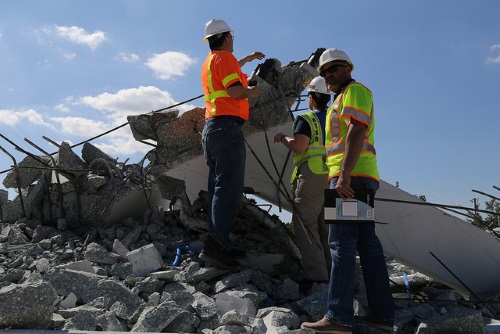The National Transportation Safety Board determined engineering errors are the probable causes of a fatal pedestrian bridge collapse that occurred last year in Miami. Those errors caused the partially constructed 174-foot-long, 950-ton Florida International University pedestrian bridge to crack and subsequently collapse, killing six people and injuring 10 others when it fell onto the street below, crushing eight vehicles.
[Above photo by NTSB.]
“Errors in bridge design, inadequate peer review and poor engineering judgment led to the collapse of this bridge,” NTSB Chairman Robert Sumwalt explained in a three-hour public hearing on October 22.

“The failure of all concerned parties, to recognize and take action on the threat to public safety presented by the significant observed bridge structure distress prior to the collapse, led to the tragic loss of life in this preventable accident,” he said.
Faulty calculation errors made by FIGG Bridge Engineers, Inc. – compounded by what was called an “inadequate peer review” conducted by engineering firm Louis Berger – were the main “probable causes” of the elevated walkway’s failure, the agency said; representing two of 30 findings NTSB issued in its analysis of the incident which occurring on March 15, 2018.
NTSB added that its final report on this incident will be released “in the coming weeks.”
Based on its investigation of the bridge collapse, the agency issued 11 safety recommendations in total, with one issued to the Federal Highway Administration, five issued to the Florida Department of Transportation, three issued to the American Association of State Highway and Transportation Officials, and two issued to FIGG Bridge Engineers, Inc.

The three recommendations issued to AASHTO were:
- Work with the FHWA to develop a requirement that concrete bridge structures be designed with reasonable estimates for interface shear demand, the cohesion and friction contributions to interface shear capacity, and the clamping force across the interface shear surface.
- Add a discussion about redundancy in the design of concrete structures to section five of the organization’s Load and Resistance Factor Design or LRFD Bridge Design Specifications.
- Add a discussion about redundancy to the LRFD Guide Specifications for the Design of Pedestrian Bridges, emphasizing uncommon bridge structures.
The Florida DOT noted in a statement that it is already implementing changes to its interactions with project sponsors and the processes the agency employs relating to major local agency program projects as a result of the NTSB’s investigation
“The events surrounding the FIU bridge collapse are absolutely heartbreaking for both the families and loved ones of the victims, but also for the community and state,” said Kevin Thibault, Florida DOT’s secretary, in a statement.
“The department has and will continue to cooperate fully with the NTSB as part of this process and has already implemented many of the improvements discussed today,” he added. “I remain committed to ensuring that all NTSB recommendations are followed so a tragedy like this never happens again in Florida.”
 Top Stories
Top Stories
Modal Administrators Speak at AASHTO Annual Meeting
December 5, 2025 Top Stories
Top Stories

